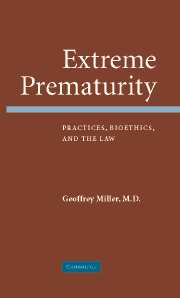Book contents
- Frontmatter
- Contents
- Part 1 THE EXTREMELY PRETERM INFANT: EPIDEMIOLOGY, PERCEPTIONS, AND PRACTICES
- Part 2 BIOETHICS
- 14 Moral Theory
- 15 Autonomy
- 16 Beneficence and Nonmaleficence
- 17 Justice
- 18 Sanctity of Life
- 19 Active and Passive Euthanasia
- 20 Personhood
- 21 Quality of Life and Best Interests
- 22 Futility
- Part 3 REPORTS, OFFICIAL OPINIONS, AND GUIDELINES
- Part 4 THE LAW
- Part 5 EPILOGUE: TRUTH, TRUST, AND BOUNDARIES
- References
- Index
19 - Active and Passive Euthanasia
Published online by Cambridge University Press: 23 September 2009
- Frontmatter
- Contents
- Part 1 THE EXTREMELY PRETERM INFANT: EPIDEMIOLOGY, PERCEPTIONS, AND PRACTICES
- Part 2 BIOETHICS
- 14 Moral Theory
- 15 Autonomy
- 16 Beneficence and Nonmaleficence
- 17 Justice
- 18 Sanctity of Life
- 19 Active and Passive Euthanasia
- 20 Personhood
- 21 Quality of Life and Best Interests
- 22 Futility
- Part 3 REPORTS, OFFICIAL OPINIONS, AND GUIDELINES
- Part 4 THE LAW
- Part 5 EPILOGUE: TRUTH, TRUST, AND BOUNDARIES
- References
- Index
Summary
Kuhse wrote that killing is not always morally worse than letting die and sometimes may be better.(205) She argued that active euthanasia is morally no worse than passive euthanasia and sometimes morally better. This, she stated, is based on the motivation of the agent, as the two acts have the same outcome. The actors, parents and physicians believe they are doing good, which, in itself, is based on the notion that the outcome, death, is good, or much better, than the alternative, a life with severe disability. Although the moral notion, in some circumstances, may be seen by some as acceptable, it is based on an abstraction akin to the legal term non actus reus nisi mens sit rea (knowledge of the wrongfulness of an act at the time of its commission) and in the case of foregoing life-sustaining treatment for an extremely preterm infant, is not a verifiable proposition. Whereas the actors may believe they are doing good, this is based on their perceptions and judgments, which have been molded by anecdote, bias, prejudice, custom, and taboo. For example, it was not that long ago that children with Down syndrome were left to die from conditions that were correctable. Recent history is replete with acts performed by professionals that at the time were not believed by them to be bad but would be judged as such now.
- Type
- Chapter
- Information
- Extreme PrematurityPractices, Bioethics and the Law, pp. 72 - 73Publisher: Cambridge University PressPrint publication year: 2006



